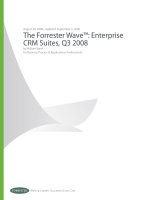Tài liệu The Dock ppt
Bạn đang xem bản rút gọn của tài liệu. Xem và tải ngay bản đầy đủ của tài liệu tại đây (21.88 KB, 1 trang )
4.1. The Dock
For years, most operating systems maintained two different lists of programs. One listed
unopened programs until you need them, like the Start menu (Windows) or the Launcher
(Mac OS 9). The other kept track of which programs were open at the moment for easy
switching, like the taskbar (Windows) or the Application menu (Mac OS 9).
In Mac OS X, Apple combined both functions into a single strip of icons called theDock.
Apple's thinking goes like this: Why must you know whether or not a program is already
running? That's the computer's problem, not yours. In an ideal world, this distinction
should be irrelevant. A program should appear when you click its icon, whether it's open
or not—like on a PalmPilot, for example.
"Which programs are open" already approaches unimportance in Mac OS X, where
sophisticated memory-management features make it hard to run out of memory. You can
open dozens of programs at once in Mac OS X.
And that's why the Dock combines the launcher and status functions of a modern
operating system. Only a tiny white reflective dot beneath a program's icon tells you that
it's open.
Whether or not you agree with Apple's philosophy (and not everyone does), Apple has
made it as easy as possible to learn to like the Dock. You can customize the thing to
within an inch of its life, or even get rid of it completely. This section explains everything
you need to know.









